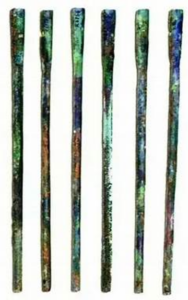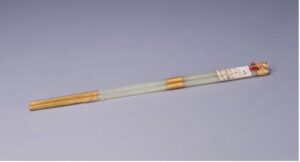Today it is April 20, Chinese Language Day. What is more Chinese than chopsticks? Xie Rongrong takes you on a journey of the origin of the word chopstick.
Chopsticks are more than just utensils – they are a timeless symbol of culture, history, and even a little bit of magic. Used for thousands of years, these simple sticks have fed empires, inspired traditions, and even shaped language. But did you know their names hide stories of superstition, efficiency, and cross–cultural connections? From their ancient origins to their modern–day significance, chopsticks are packed with fascinating tales. Let’s dive into their history, uncover their meanings, and explore why they’re so much more than just tools for eating.
1. The Etymology of “Chopstick”: A Linguistic Bridge Between East and West
The English word chopstick has its origins in the cultural and linguistic exchanges between China and the West during the 17th and 18th centuries, a period marked by the rise of Chinese Pidgin English (CPE). CPE is an outcome of the language contact between speakers of Chinese and of European languages, widely used along the coast of China in the 18th and 19th century. It’s a simplified trade language, blending elements of English, Portuguese, and Chinese, emerged in ports like Canton (nowadays Guangzhou) and Shanghai to facilitate communication between Chinese merchants and European traders. It was possibly through this linguistic medium that the term chopstick first appeared. Chopsticks are thousands of years old, and Western writers documented Chinese eating habits as early as 1540 (Portuguese). The word chopstick first appears in English in 1699 in William Dampier’s Voyages and Descriptions describing his 1688 visit to Asia.
The Oxford English Dictionary and other major sources support the argument that the word chopstick is linked to the Pidgin English phrase chop–chop, meaning “quick” or “fast”. This connection stems from the observation that the Chinese eat with sticks, which enable them to eat efficiently, hence the other term “fast–sticks”. The initial part of the word, chop, is first noted in the interaction between Cantonese and English–speaking people in British concessions in Southern China. This Pidgin phrase spread through Chinese workers at sea and was adopted by British seamen. “Chop chop” means “hurry” and suggests that something should be done now and without delay, and it was related to the Cantonese word 快 (kwaai), reflecting the utensil’s efficiency . The second part, stick, refers to the utensil’s shape – a thin, elongated piece of wood, bamboo, or similar material. By combining chop and stick, the term chopstick was formed, literally meaning “quick stick”, emphasizing the speed and practicality of using these utensils for eating.
2. The Origins and legend of Chopsticks in China

In earlier times, chopsticks were called 梜 (jiā) and they also had another name, 箸 (zhù). Legend has it that chopsticks were invented by Jiang Ziya (c. 1156 BC – c. 1017 BC), a Chinese militarist, statesman, tactician, and thinker at the end of the Shang Dynasty and founding father of the Western Zhou Dynasty. He was inspired by a divine bird to create bamboo chopsticks. An alternative tale is that they were invented by Yu the Great (c. 2123 BC – c. 2025 BC), the founding monarch of the Xia Dynasty, during his efforts to control floods. Due to his busy schedule, in order to save time while eating, he used two tree branches as tools. The above, of course, belongs to the realm of legend. A more plausible explanation is that, after the advent of fire–making by drilling wood, the ancestors, who once ate raw meat and drank blood, began to consume warm, cooked food. Using their hands to handle hot food became inconvenient, leading to the emergence of early chopsticks. Although this remains speculative, it is true that during the pre–Qin period (before 221 BC), the words 梜 (jiā) or箸 (zhù) were only used for picking up vegetables. The Book of Rites: Qu Li I (West Han Dynasty, 202 BC–8 CE) states, “For soup with vegetables, use 梜 (jiā); for soup without vegetables, do not use 梜 (jiā).” Here, “soup” does not refer to the modern concept of broth but rather to a dish made with meat or vegetables in a sauce, for which chopsticks were clearly more suitable for eating.
In addition to the more common bamboo and wooden chopsticks, there are also chopsticks made from various other materials. At the Ruins of Yinxu in Anyang site, six bronze chopstick heads were unearthed, which could be attached to handles for use. Additionally, chopsticks made of ivory and bronze have been discovered at sites dating back to the late Shang Dynasty (1766 BC–1122 BC) and the Zhou Dynasty (c. 1046 BC– 256 BC).
During the Northern (386 CE–581 CE) Dynasty and Southern Dynasty (420 CE–589 CE), emperors bestowed redwood chopsticks inlaid with gold filigree upon their officials as rewards. By the powerful and prosperous Tang Dynasty (618 CE–907CE), chopsticks came in an even greater variety, including gold and jade chopsticks, making them highly valuable.

3. The Evolution of the Chinese Term: From 箸 (Zhù) to 筷子 (Kuàizi)
The name 筷子 (kuàizi) likely emerged during the Ming Dynasty (1368 CE–1644 CE). In the text Shuyuan Miscellany (菽园杂记) in Ming Dynasty records, it is written: “Folk taboos exist everywhere, but they are particularly strong in the Wu region (this mainly includes Jiangsu Province and Zhejiang Province in China). For example, when sailing, people avoid words like 住 (zhù), ‘to stop’ and 翻 (fān), ‘to overturn’, so 箸 (zhù) is replaced with 快儿 (kuài’er) , ‘fast’.” Because the word 箸 (zhù) sounds identical to 住 (zhù) , “to stop”, it was considered unlucky due to its implied connotations of stagnation or misfortune. This superstition was particularly strong among boatmen and travelers, who avoided the term to prevent bad luck. Instead, they adopted the word 快儿 (kuài’er), meaning “fast” to express wishes for swift sailing and good fortune. Given that chopsticks were typically made of bamboo or wood, the character or radical 竹 (zhú) “bamboo” was added to 快 (kuài), forming the character 筷 (kuài).
 Over time, this new name gained widespread popularity among the general population and eventually became accepted even by the scholar–official class. By modern times, the term had been standardized as 筷子 (kuàizi). Here, in Chinese, both 儿 (ér) and 子 (zǐ) in 快儿 (kuài’er) and 筷子 (kuàizi) are common suffixes. While 子 (zǐ) serves as a nominal suffix that helps form a complete noun, 儿 (ér) adds a colloquial or affectionate nuance to the word 快 (kuài). On their own, these suffixes do not carry specific meanings, but they play important roles in word formation and tone.
Over time, this new name gained widespread popularity among the general population and eventually became accepted even by the scholar–official class. By modern times, the term had been standardized as 筷子 (kuàizi). Here, in Chinese, both 儿 (ér) and 子 (zǐ) in 快儿 (kuài’er) and 筷子 (kuàizi) are common suffixes. While 子 (zǐ) serves as a nominal suffix that helps form a complete noun, 儿 (ér) adds a colloquial or affectionate nuance to the word 快 (kuài). On their own, these suffixes do not carry specific meanings, but they play important roles in word formation and tone.
The adoption of 筷子 is a good example for the Chinese practice of linguistic avoidance, where words with negative connotations are replaced with more auspicious alternatives. This cultural sensitivity is deeply rooted in Chinese traditions and continues to influence language use today.
4. A Piece of History Behind a Pair of Chopsticks
Behind a pair of chopsticks, there may also lie a piece of history. Both Han Feizi: Yu Lao (a philosophical text written by Han Feizi (c. 280 BC–233 BC)) and Records of the Grand Historian: The House of Song Weizi (written by the Han dynasty historian Sima Qian) mention an anecdote about ivory chopsticks. In the latter one can read: “King Zhou (the last monarch of the Shang Dynasty) began using ivory chopsticks, upon which Jizi (the Grand Preceptor of the Shang Dynasty and the uncle of King Zhou) sighed, “If he uses ivory chopsticks, he will surely desire jade cups next.”
 During the Shang Dynasty, King Zhou favored using chopsticks made of ivory. When Jizi learned of this, he found it deeply troubling. Ivory chopsticks were undoubtedly a luxurious utensil, and from there, it was likely that King Zhou would develop a taste for even more extravagant items, such as jade cups, gradually sinking into a life of extravagance and excess.
During the Shang Dynasty, King Zhou favored using chopsticks made of ivory. When Jizi learned of this, he found it deeply troubling. Ivory chopsticks were undoubtedly a luxurious utensil, and from there, it was likely that King Zhou would develop a taste for even more extravagant items, such as jade cups, gradually sinking into a life of extravagance and excess.
Sure enough, King Zhou later indulged in pleasure–seeking, ultimately leading to his downfall when King Wu of Zhou attacked and captured the capital. The historical anecdote of “Ivory Chopsticks and Jade Cups” (象箸玉杯 xiàng zhù yù bēi) is closely tied to this story.
Today, chopsticks are a global phenomenon. While they’re a fundamental dining tool in Asian countries, they’ve also found their way into kitchens and restaurants worldwide. Chopsticks are not just utensils, but they also carry cultural symbolism. In East Asian societies, they symbolize harmony, dexterity, and centuries–old traditions. The word chopstick is a fascinating example of how language evolves through language contact and cultural interaction. Whether you’re using them to enjoy noodles or sushi or digging into their history, chopsticks are more than just utensils – they’re a bridge between East and West. Their journey, from their creation to their widespread use, isn’t just about food; it’s a story of how culture spreads and connects us all.
More to read:
Baker, Philip. 1987. Historical Developments in Chinese Pidgin English and the Nature of the Relationships Between the Various Pidgin Englishes of the Pacific Region. Journal of Pidgin and Creole Languages 2(2). 163–207. https://doi.org/10.1075/jpcl.2.2.04bak.
Dampier, Willian. 1699. Voyages and Descriptions. Vol. 2. London: Printed for James Knapton, at the Crown in St Pauls Church-yard.
Li, Michelle. 2016. Trade Pidgins in China: Historical and Grammatical Relationships. Transactions of the Philological Society 114(3). 298–314. https://doi.org/10.1111/1467-968X.12066.
Morse, Hosea Ballou. 1926. The Chronicles Of The East India Company Trading To China 1635-1834. Oxford: The Clarendon Press.
Shi, Dingxu. 1991. Chinese Pidgin English: Its Origin and Linguistic Features. Journal of Chinese Linguistics 19(1). 1–42.
Shi, Dingxu. 1992. Learning Pidgin English Trough Chinese Characters. In Francis Byrne & John Holm (eds.), Atlantic Meets Pacific: A global view of pidginization and creolization, vol. 11, 459–464. Amsterdam: John Benjamins Publishing Company. https://doi.org/10.1075/cll.11.45shi.
Whinnom, Keith. 1971. Linguistic hybridization and the “special case” of pidgin and creoles. In Dell Hymes (ed.),. In Pidginization and creolization of languages, 91–115. Cambridge ; New York: CUP.
Xie, Rongrong. 2019. A Study of Pidgin English book in Late-Qing Ningbo(宁波晚清洋泾浜文本《英话注解》语言文化研究). Zhejiang: Zhejiang University Press.
Xie Rongrong is a professor from Ningbo Childhood Education College in China and currently, she is a visiting scholar in Aarhus University. Her major research fields are Chinese Pidgin English, Language Contact and Cultural interaction.







